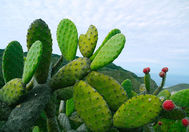










La Palma - The Isla Bonita enchants with its versatility
La Palma, also known as 'La Isla Bonita' (The Beautiful Island) and historically as San Miguel de La Palma, is the northwesternmost island of the Canary Islands, Spain. It's part of Spain's autonomous community and the Macaronesian archipelago in the Atlantic Ocean.
Geography and Nature Renowned for its breathtaking landscapes, impressive volcanoes, dense forests, unique beaches, and starry skies, La Palma covers an area of 708.32 km² with a coastline of 166 km. The highest point is the Roque de los Muchachos, standing at 2,426 meters. Designated as both a Biosphere Reserve and a Starlight Reserve, the island boasts a wide range of landscapes and climates.
Population and Language As of early 2023, La Palma had a population of approximately 84,338 inhabitants, known as 'Palmeros'. Spanish, particularly Canary Island Spanish, is the primary language. The island is home to Spanish and Canary Island residents, as well as other minority groups.
Economy La Palma's economy primarily relies on irrigated agriculture. Agricultural products and embroidery are exported from the port of Santa Cruz de La Palma. Tourism also plays a significant role in the island's economy.
History La Palma has a rich history dating back to pre-Hispanic times. The island was once inhabited by the Benahoaritas before being conquered by the Spanish in the 15th century. Numerous historical sites bear witness to its past.
Volcanism The island's volcanic activity is evident in recent eruptions like the 2021 Cumbre Vieja event. These eruptions have reshaped the island's landscape and spurred new research on volcanism and its environmental impacts.
Climate La Palma enjoys a mild climate with temperatures rarely dropping below 17°C or exceeding 22°C. This pleasant climate, coupled with the island's natural beauty, makes it a popular destination for tourists and nature lovers.
Transportation The island is accessible via La Palma Airport and the seaport of Santa Cruz de La Palma. A network of roads and hiking trails facilitates exploration.
Water Tunnels A notable feature of La Palma is its water tunnels, crucial for irrigation and water supply. These tunnels exemplify engineering ingenuity and adaptation to the island's geography.
Observatories Due to its clear skies and minimal light pollution, La Palma hosts some of the world's most advanced observatories. The Roque de los Muchachos is a prime location for astronomical observations and research.
Conclusion La Palma is a place of extraordinary natural beauty and diversity. The island offers a unique blend of natural wonders, cultural heritage, and scientific research, attracting visitors from around the globe. Despite recent volcanic activity, La Palma remains an Atlantic gem, welcoming visitors with open arms and providing an unforgettable experience.
Some pictures from La Palma:
Travel guide for the Canary Islands you get here on Amazon!*
La Palma: Activities for Every Taste
La Palma, the green island of the Canary Islands, offers a diverse range of activities for nature lovers, adventurers, and those seeking relaxation.
Hiking: La Palma is a hiker's paradise with a well-developed network of trails for all levels of difficulty. From easy walks along the coast to challenging climbs to the island's highest peak, Pico de las Nieves, there's something for everyone.
Stargazing: Thanks to minimal light pollution and clear skies, La Palma is an ideal place for stargazing. Visit the Roque de los Muchachos Observatory, home to the world's largest optical telescope, and marvel at the Milky Way and other cosmic wonders.
Whale and Dolphin Watching: The waters around La Palma are rich in marine life, including whales, dolphins, and sea turtles. Take a boat trip and observe these fascinating creatures in their natural habitat.
Caving: La Palma's volcanic origins have left behind a network of caves waiting to be explored. Visit the Cueva del Viento, the world's longest lava tube, and admire the impressive volcanic formations.
Other Activities:
Visit the Salinas de Fuencaliente, traditional salt flats where salt is still harvested today using centuries-old methods.
Discover charming towns and villages, such as Santa Cruz de La Palma with its colorful colonial architecture.
Swim or dive in the crystal-clear waters around the island.
Relax on the black sand beaches, such as Playa de Echentive.
Take a scenic drive through the island's lush landscape and enjoy the breathtaking views.
Sample the local cuisine, which is characterized by fresh seafood and regional products.
Visit the island's wineries and taste the delicious wines produced from La Palma's volcanic soils.
La Palma is an ideal destination for an active vacation. With its diverse activities, stunning landscapes, and welcoming atmosphere, the island offers everything you need for an unforgettable holiday.
Here's some extra info to help you plan your La Palma adventure:
The sweet spot for visiting La Palma is from October to May. Summers can be pretty toasty and dry.
La Palma's a popular choice, so it's smart to book your stay and flights ahead of time.
The island has a great public transport system, so you can easily explore without a car.
While Spanish is the official language, English is widely spoken too.
Happy planning for your La Palma getaway!












